Abandoned Mine Drainage
Abandoned Mine Drainage
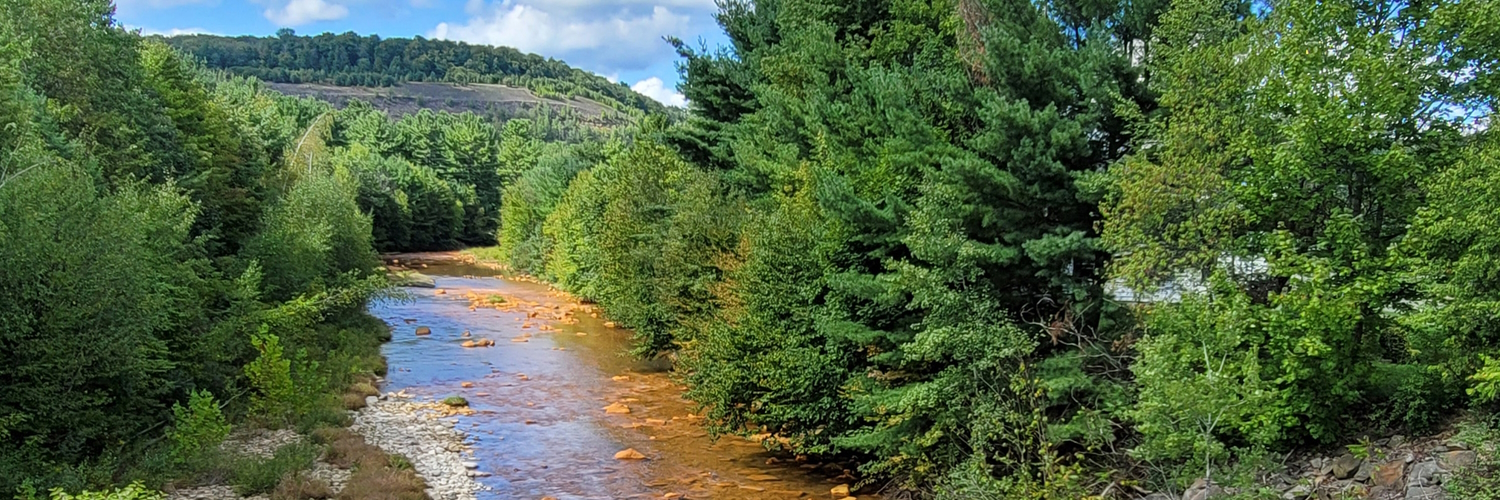
What is Abandoned Mine Drainage?
Project Highlight: Tioga River
What is Abandoned Mine Drainage?
From the colonial iron industry of the mid-1700s to the steel industry of the 1800s and electricity generation of today, coal mining has been the primary fuel source of our modern world.
Once coal from one site was depleted, operators would simply move to the next one. Nearly a quarter of a million mine lands were abandoned in Pennsylvania leaving environmental and safety hazards behind. Until 1977, there were no state or federal requirements to fix these hazards left by depleted or abandoned coal mining activities.
More than 5,500 miles of waterways in PA are affected by abandoned mine drainage (AMD) — polluted water that flows out of abandoned mines and often laden with acid and/or dissolved metals including iron and aluminum.
SRBC's Mine Drainage program involves assessment and planning initiatives that lead to design and construction of AMD treatment systems and abandoned mine land (AML) reclamation projects throughout the basin.
Mine Drainage Portal
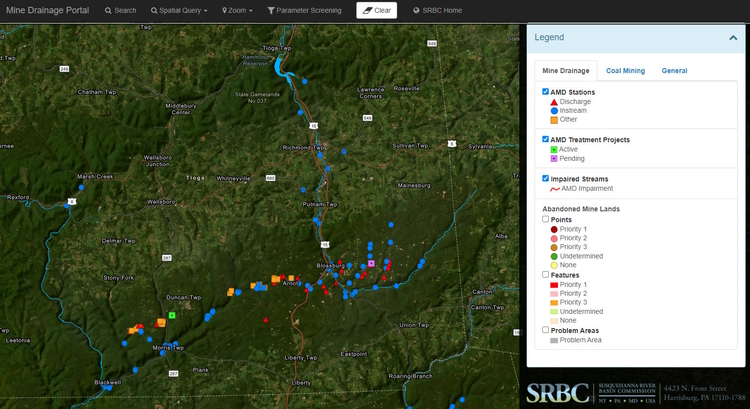 A view of SRBC's Mine Drainage Portal shows the locationof monitoring stations and status of AMD treatment
projects in Tioga County, PA.
A view of SRBC's Mine Drainage Portal shows the locationof monitoring stations and status of AMD treatment
projects in Tioga County, PA.
SRBC's Mine Drainage Portal provides data compiled as part of the Commission's efforts to assess impacts to water quality from mine drainage in the basin.
Within the Portal, you will find chemical data for parameters typically associated with mine drainage impacts within the rivers and streams in the river basin.
Project Highlight: Tioga River
Five large deep mine discharges in the smaller Northern Bituminous Coalfield near the town of Blossburg, PA, in Tioga County are rendering the Tioga River lifeless.
A mine discharge treatment plant to improve the quality of the Tioga River from Blossburg to Mansfield, PA, is underway under a SRBC partnership with the PA Department of Environmental Protection, Department of Conservation and Natural Resources, Tioga County Concerned Citizens Committee, and Northcentral Pennsylvania Conservancy.
The project will correct this impairment, restore over 20 miles of streams, and improve the water quality of Tioga Lake. Once constructed, the plant will treat on average just over 5 million gallons per day of polluted water.
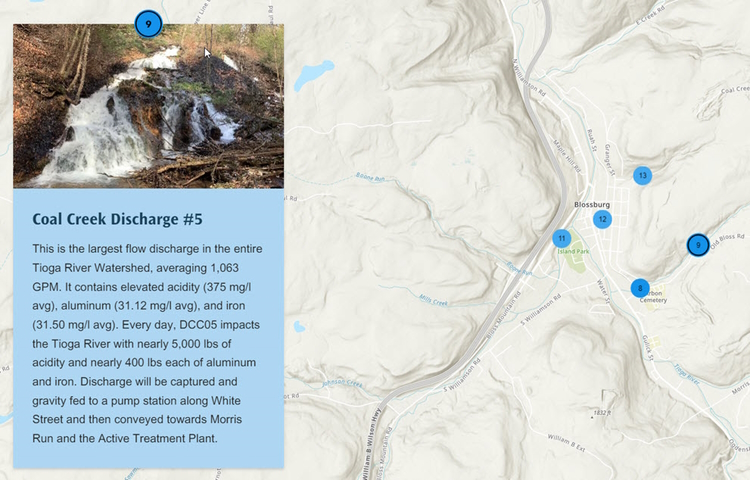 Visit the
Tioga River AMD Treatment Plant Project story map
for a tour of the study area and how the treatment plant will
raise the pH of the drainage water to precipitate dissolved
metals for capture and disposal.
Visit the
Tioga River AMD Treatment Plant Project story map
for a tour of the study area and how the treatment plant will
raise the pH of the drainage water to precipitate dissolved
metals for capture and disposal.
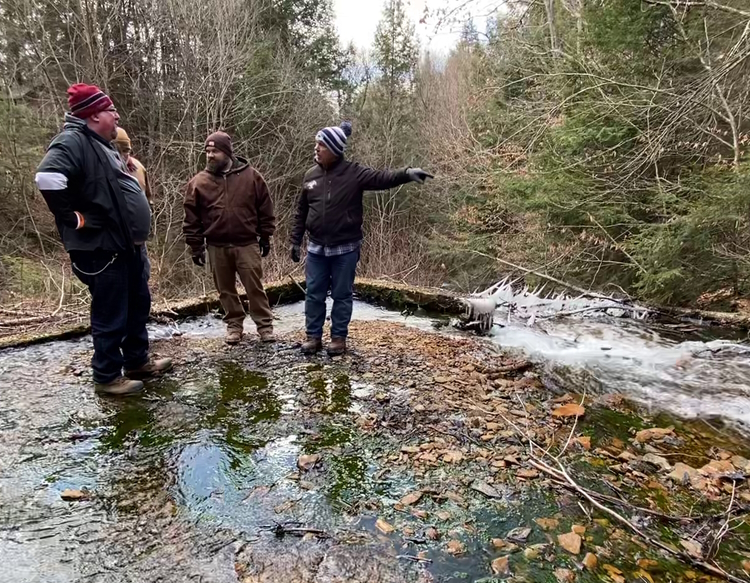 Tom Clark (left),
SRBC's Mine Drainage
Program Coordinator,
consults with contractors
during a tour of areas to
be cleaned-up with a
future active treatment
plant in the Tioga
watershed.
Tom Clark (left),
SRBC's Mine Drainage
Program Coordinator,
consults with contractors
during a tour of areas to
be cleaned-up with a
future active treatment
plant in the Tioga
watershed.
FACTS about AMD
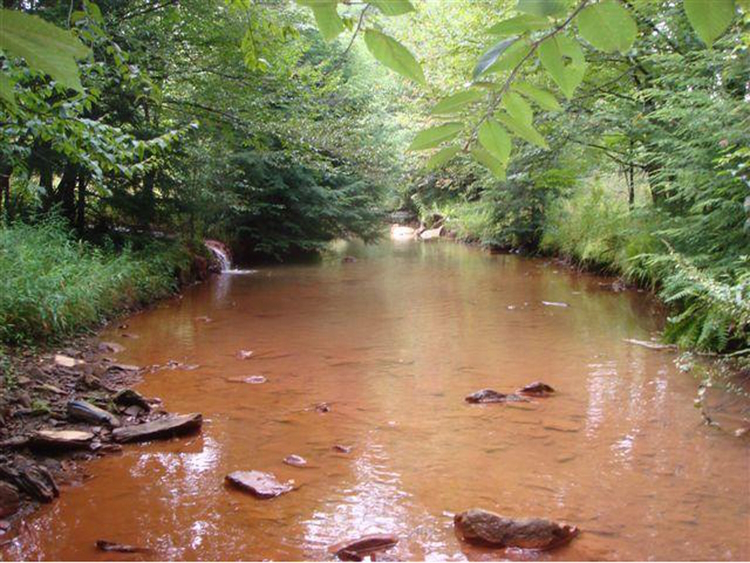 AMD's distinctive orange-colored streams are the
result of water draining from abandoned mines that
are packed with iron-oxide, essentially rust, which
has leached out of iron deposits underground.
AMD's distinctive orange-colored streams are the
result of water draining from abandoned mines that
are packed with iron-oxide, essentially rust, which
has leached out of iron deposits underground.
- Abandoned mine drainage is the second highest cause of water pollution in Pennsylvania.
- AMD discharges can be acidic or alkaline. Both types of discharges can cause natural substances in rock that are toxic to aquatic life to dissolve into the water.
- Acid mine drainage can be 10,000 times more acidic than neutral water.
-
Common ways to treat acid mine drainage
include:
- Active treatment, such as treatment plants that add lime or other neutralizing material to reduce the acidity, causing the metals to settle out of the water (precipitate) before reaching the stream.
- Passive treatment, such as wetlands that help sequester contaminated materials and promote microbial action, which can also help treat mine drainage by precipitating metals.
Partnerships Tackle AMD Priority Sites
Abandoned Mine Drainage (AMD) runoff pollutes ground and surface waters. Areas affected by AMD include the Main Bituminous Coalfield (soft coal) that impacts parts of the West Branch Susquehanna River and Juniata River Subbasins , as well as the Anthracite Coalfields (hard coal) in the eastern portion of the Susquehanna River Basin.
Treatment and restoration of abandoned mine lands and affected waterways can take many years and millions of dollars. But allowing polluted discharges to decline over time by natural depletion of the acid-forming minerals takes much longer, particularly for underground mines. Meanwhile, significant environmental impacts — elimination of aquatic life, pollution of drinking water, and impact on tourism and recreation — could continue for centuries.
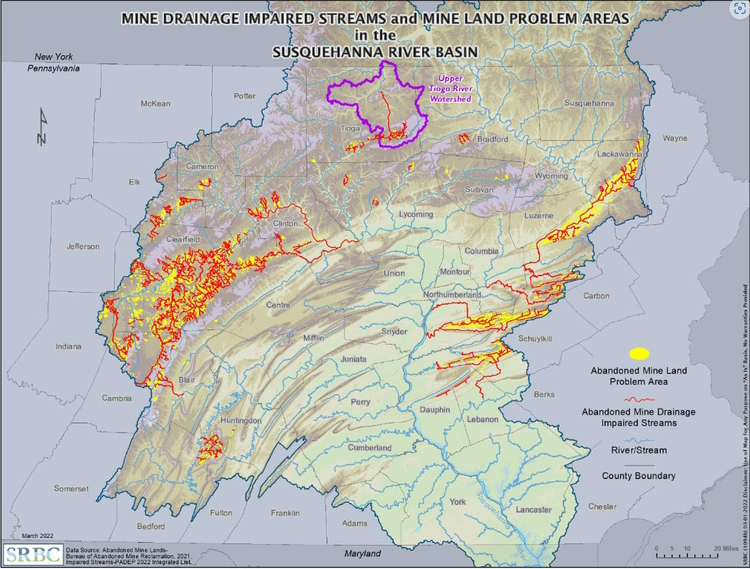 Mine drainage issues in the PA portion of the Susquehanna River Basin.
Mine drainage issues in the PA portion of the Susquehanna River Basin.